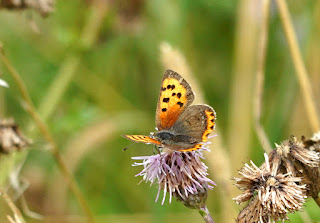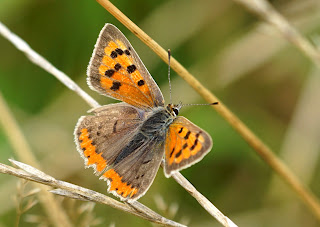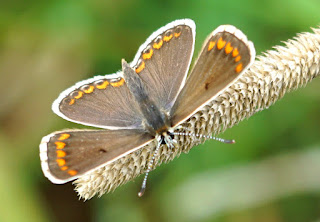The high light of my visit to Cranford Park yesterday was finding a glorious huge female Wasp Spider. Unfortunately I could only get a photo of her under carriage, rather than the top of her which is intricately patterned just like a wasp. The females are larger and more colourful than the small drab brown males. The females are quite ferocious, but only to the males and their prey, they are completely harmless to us humans.
Females are known to eat the males if they dont get out of the way quick enough after mating.
I have seen these colourful spiders at Cranford Park before, but not for a few years. I could only find one yesterday and hope to find some more on my next visit.
They spin unusual webs with a distinct zig zag pattern from the centre of the web down to the bottom. This specimen that I found was lacking the zig zag effect, but it had rained during the night so she was slowly rebuilding her net ...
 |
| The under carriage. You can see the appendage where the silk comes out. |
The butterfly transect was good, It revealed Cranford Park is experiencing a second flush of both Small Copper and Brown Argus, which I dont always see each season. They were very fresh looking specimens, and as tiny as ever which made counting them very difficult at times.
I had a total of 68 butterflies of 10 species, a bit down from my last count on 4th August when I had 115 butterflies of 13 species but it was much cooler and overcast yesterday.
Recorded 20/08/21
Large White
Small White
Small Copper
Brown Argus
Common Blue
Holly Blue
Red Admiral
Comma
Speckled Wood
Meadow Brown
and here come the pics ....
 |
| Comma |
 |
| tatty male Meadow Brown |
 |
| Red Admiral on the information board by the wildlife pond. I'm not sure if the Peacock illustration |
confused it or not
 |
| Red Admiral |
 |
| Red Admirals |
 |
| Small Copper |
 |
| Small Copper |
 |
| Small Copper |
 |
| Brown Argus |
 |
| Brown Argus |
 |
| Brown Argus |
 |
| Brown Argus |
Along with the huge Volucella hoverflies I spotted on my last visit, yesterday my eye was caught by one of the smallest hoverfly species, Sphaerophoria scripta, just 5mm long and very addictive to watch ...
I found several clumps of this coral fungi, which I believe to be Clauvulina coralloides aka Crested Coral ....
The young oaks along the river Crane are showing signs that a gall wasp has been busy. These are Silk Button galls caused by the Neuroterus numismalis gall wasp. They have two generations each year, one being sexual and the other being agamic (ie no males needed to reproduce). The sexual generation cause Blister galls on oak leaves, but the agamic generation produce these delicate looking Silk Button galls ....
The larva in each tiny gall matures in August but they stay in the gall even when the leaves drop in autumn, finally emerging as an adult the following spring ....
After my transect I like to walk along the river and hope for a glimpse of one of the Kingfishers. No luck yesterday but this young juvenile Green Woodpecker was on the path, along with a racing pigeon ...
It being a week day, the park was fairly quiet which meant the local rabbits were more easily seen ....
and the Grey Squirrels by the large oaks, who are never shy, were busy feeding up ....
After my last blog where I was uncertain whether Buzzards bred in the woods, Tony James contacted me to confirm he and his lovely missus had spotted food passes between adults and juveniles over the park, so it looks as if Common Buzzards did indeed breed in Cranford Park this year, which is really great news.
Yesterday afternoon there was a Little Owl calling near the old sweet chestnut tree, but despite a lot of searching I never did manage to locate it, so have no idea if it was a juvenile or adult, but it's comforting to know they are still there.
As always, a great visit to the park, with plenty to see including some of the regulars like Phil with his two adorable dogs, Ellie and Scruffy, and of course Martyn who is always being kept busy these days :) And it was good to know that one of the other regulars, Meena, had spotted the caterpillar of the Elephant Hawk-moth near the river recently. A great find for the park.








































